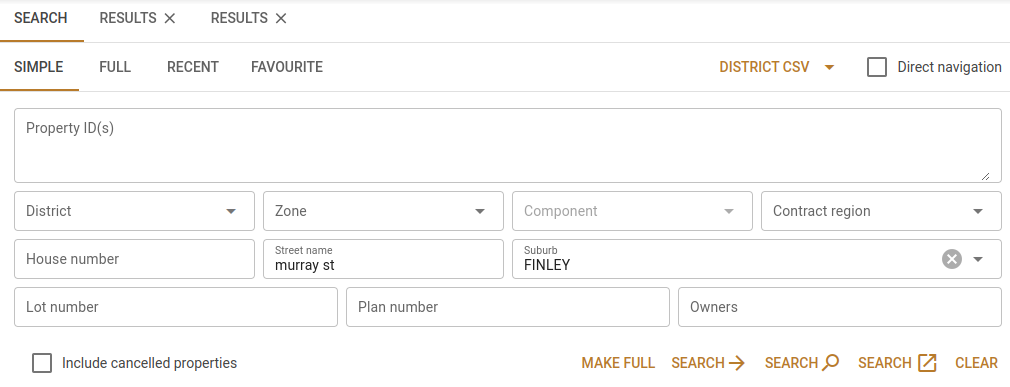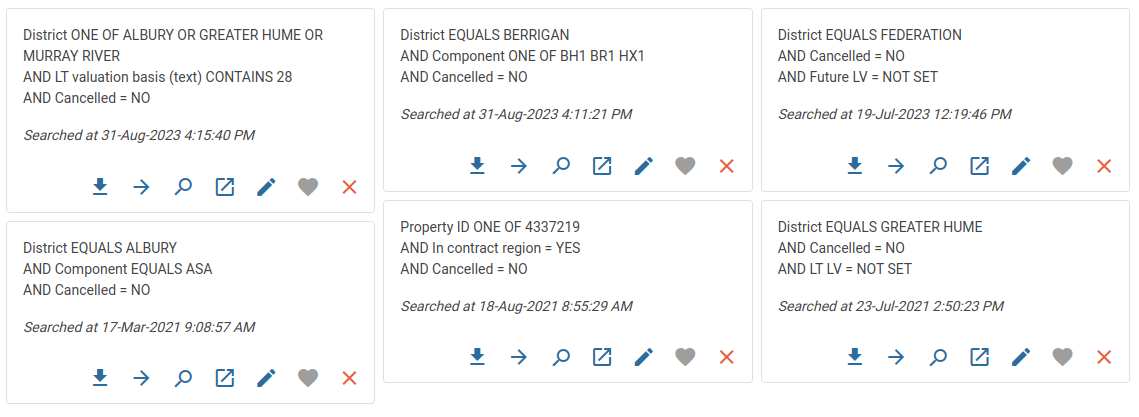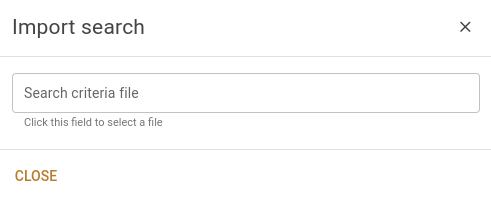Appearance
Searching in MVOW
Searching is one of the most fundamental skills for using MVOW. Searching can be used to find individual Property, Supp, Analysis or Sale items. More frequently, it is used to find sets of items that can be managed, exported, viewed or edited in bulk.
Searching is a three step process
- Define the search criteria.
- Perform the search.
- Work with the search results.
Create your first search
Define the search criteria
When you want to find something in a database, you need to tell the system what types of things you want returned. We do this by specifying search criteria.
Let’s say we want to find all properties on the street named Murray in the suburb of FINLEY.
To specify this search criteria, we need to tell the system:
- Show me all properties whose street is named murray
- But only when those properties are also in the suburb of FINLEY
You can do this most easily using Simple search.
- From the Properties menu item, select the Simple tab.
- In the Street name field, enter
murray. - In the Suburb field, begin entering
finley. When you have entered enough characters, you will be able to chooseFINLEYfrom the drop-down list.
When you are done, your search criteria will look like this.

Now you are ready to perform the search.
I’m using murray and FINLEY as examples only. If you are following along, make sure you use a Street name and Suburb from your own district.
Perform the search
To perform the search, press the Search  button.
button.
Pressing the search button is all you have to do, MVOW will do the rest. MVOW is now busily finding all the properties in streets whose names contain murray in the suburb of FINLEY.
Work with the search results
When the search has completed, it lists all the properties matching the search criteria.
In looking through the search results, you may find that MVOW has returned results from multiple streets containing the name murray.
The search results contain properties from MURRAY ST as well as MURRAY LANE.

The reason Simple search returns properties from MURRAY ST and MURRAY LANE is because Simple search implicitly uses the CONTAINS operator for the Street name field.
The search string murray is found in both MURRAY ST and MURRAY LANE, so both street names CONTAINS the criterion murray.
Let’s say you want to narrow down the search results to only return results for MURRAY ST. To do this, you would need to refine your search criteria to specify murray st.

Now the search results include only properties from MURRAY ST.
There’s a lot more to be said about working with search results. See Working with search results.
More about search criteria
Notice that the Street name field allowed you to enter any search term you wanted, whereas the Suburb field had you select from a list.
The difference between these fields is that
- the Street name field is a free-text search field
- the Suburb field is a drop-down list field.
In the background, all free-text fields use the CONTAINS operator by default, whereas drop-down list fields use the EQUALS operator.
Tuck this idea away for now. It will come in handy once you begin to explore Full search.
Also note every field into which you enter a search criterion is joined with an AND operator.
Your search results consist of Street name CONTAINS murray stAND Suburb EQUALS FINLEY. Each additional condition you add, each will be treated as an extra AND condition. Each time you add an AND condition, you potentially return a more specific set of search results.
In addition to free-text search fields and drop-down list fields, Simple search also contains a Property ID(s) field, which takes a list of PIDs.
Here is what a list of PIDs in the Property ID(s) field looks like.
507126505878
505798
505875
505816
505860
505819
505857
505761
When you insert a list of PIDs, MVOW will only return properties relating to these particular IDs.
Beyond simple searching
When you’re familiar with Simple search, you may be ready to try Full search. Full search works similarly to Simple search, with these differences.
Comparing Simple search and Full search
| Comparison | Simple search | Full search |
|---|---|---|
| Fields | Use the nine most-frequently used search fields | Choose from a huge range of fields across the Property, Contract area, Property description, Property notes, Property leases, Property tags, Future values, LT values, LG values, Sale analysis and Worksheet categories. |
| Operators | Use the default operator for each field type | Choose from a range of operators applicable to each field type |
| Multiple criteria | Each field restricts results using AND | Each field restricts results using AND |
Try adding the Street name field to the Full search using operators EQUALS, CONTAINS and STARTS WITH using
- murray
- murray st
- murray lane
Widening full searches
Because each criterion is ANDed to the previous criteria, adding criteria generally narrows the search. However, it is possible to widen the search using ONE OF criteria. Using ONE OF criteria implicitly searches for properties that match any of the ONE OF criteria. Here’s an example.
Searching across multiple components
To search for properties over multiple components:
- specify the component field only once
- use a ONE OF comparator
- list all component identifiers in the Value field
Doing this creates an implicit OR condition between each of the component values, which widens the potential search results.

If you add two lines with a component field, you'll be looking for properties that are in both components (which is impossible) and so your search results will be empty. So if you are searching across multiple components, you must use single component line using a ONE OF comparator.
Performing the search
As you perform the search, you have a choice as to where you want search results to appear. You can choose to:
- replace the search page with the search results;
- have the search results appear in a new in-page tab; or,
- have the search results appear in a new browser tab
Replacing the search page with the search results
To replace the search criteria completely with the search results
- Press the Search
 button.
button.
The search results will replace your search criteria, and if you want to go back to change the criteria, you'll need to edit the recent search (see below).
Using in-page tabs
To have search results appear in the current page
- Press the Search
 button.
button.
Multiple search results can be managed in a single page.

- To see the criteria for each in-page tab, hover your mouse pointer over the tab name Results
 . The search criteria will appear in the tool-tip.
. The search criteria will appear in the tool-tip. - You can remove an in-page search result tab by pressing the
 in the Results
in the Results  button.
button.
Using browser tabs
To have search results pop out into a new browser tab
- Press the Search
 button.
button.
Now the search result appears in a separate tab managed by your web browser.
It can be convenient to pop your search results in a separate browser tab when you are going to be working with those search results for a long time.
Recent searches
All your most recent searches are captured on the Recent tab.
Some recent searches.

To re-run any of these searches, press either of the Search  , Search
, Search  , or the Search
, or the Search  buttons.
buttons.
If you find any of the recent searches to be something you are frequently running, you may want to make it a favourite.
To make any search a favourite, simply press the Favourite  button.
button.
Favourite searches
Favourite searches are created by pressing a Favourite  button in any search results page or any recent search.
button in any search results page or any recent search.
Once clicked, the Favourite  button turns into the Favourite
button turns into the Favourite  button.
button.

If you have made at least one favourite search, you can see your favourite searches by choosing the Favourite tab.
Unfavouriting a search
To unfavourite a search, simply click the Favourite  button. The button will switch back to the
button. The button will switch back to the
 button and it will no longer be listed on the Favourite tab.
button and it will no longer be listed on the Favourite tab.Naming a favourite search
To name a favourite, click on the Name tag  button. A named favourite will display on the Favourite tab with a name.
button. A named favourite will display on the Favourite tab with a name.

Named favourites will also appear on the Dashboard in the Named favourite searches panel. See Named favourite searches.
Editing a favourite search
To edit any favourite search, simply press the favourite’s Edit  button. Pressing the Edit
button. Pressing the Edit  button will place you in the Full search tab, where you can make any changes to the search criteria.
button will place you in the Full search tab, where you can make any changes to the search criteria.
Choosing to edit a favourite creates an entirely new search.
If you want to replace your current favourite with the new one:
- On the favourite, press Edit
 .
. - Change the search criteria.
- Run the search (
 ,
,  or
or  ).
). - Favourite
 the search result.
the search result. - On the Favourite tab, Remove
 the original favourite.
the original favourite.
Sharing searches
Exporting searches
You can download your search criteria by clicking the Download ![]() button. You search will be saved to your regular Downloads location and will be named
button. You search will be saved to your regular Downloads location and will be named search-criteria.json. Subsequent downloads will be named search-criteria (1).json and the like, so it might be worth renaming the file once it's been downloaded.
Importing saved searches
You can import your saved search by navigating to the Full search tab and clicking the Import ![]() button. The system will show you popup like this:
button. The system will show you popup like this:

Click on the Search criteria file box and browse to the file you want to load. Assuming the file is of the right type, the search will appear in the full search tab. You can then run the search and subesquently (if you want) make it a favourite.